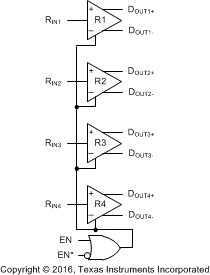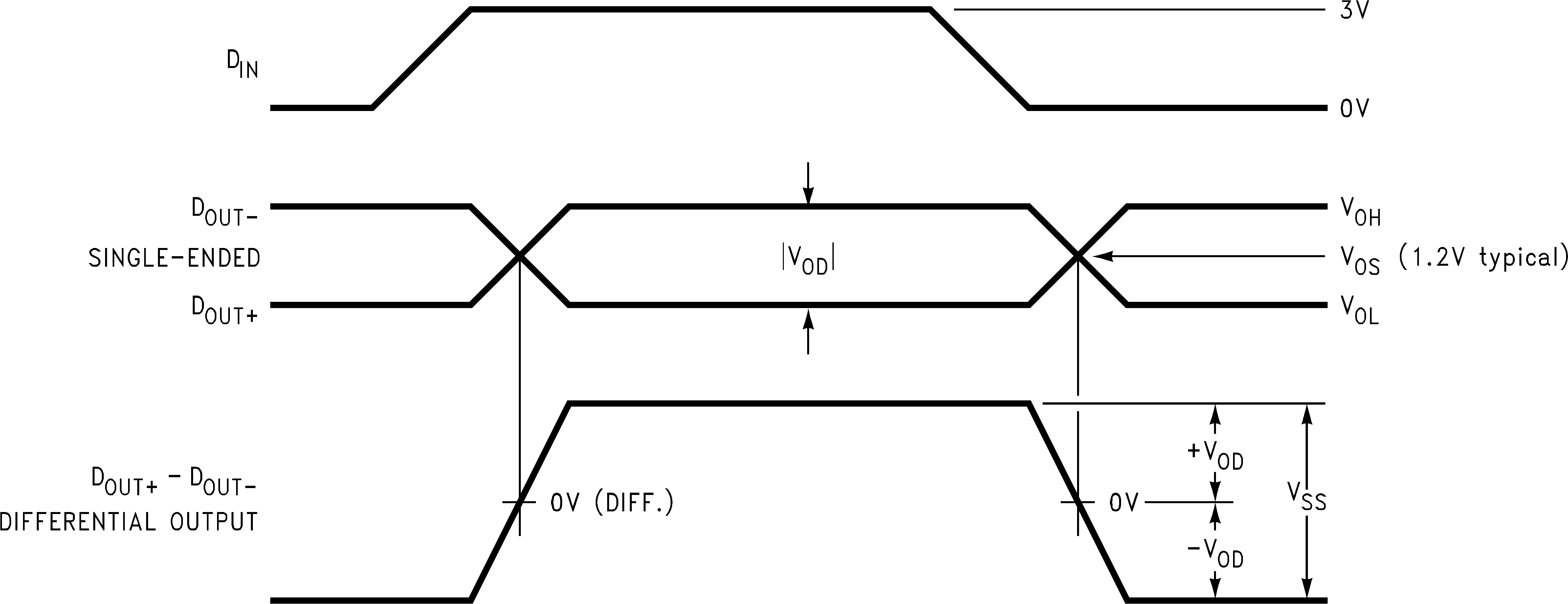SNLS020D July 1999 – August 2016 DS90LV031A
PRODUCTION DATA.
- 1 Features
- 2 Applications
- 3 Description
- 4 Revision History
- 5 Pin Configuration and Functions
- 6 Specifications
- 7 Parameter Measurement Information
- 8 Detailed Description
- 9 Application and Implementation
- 10Power Supply Recommendations
- 11Layout
- 12Device and Documentation Support
- 13Mechanical, Packaging, and Orderable Information
Package Options
Mechanical Data (Package|Pins)
Thermal pad, mechanical data (Package|Pins)
Orderable Information
8 Detailed Description
8.1 Overview
LVDS drivers and receivers are intended to be primarily used in an uncomplicated point-to-point configuration as is shown in Figure 9. This configuration provides a clean signaling environment for the quick edge rates of the drivers. The receiver is connected to the driver through a balanced media which may be a standard twisted pair cable, a parallel pair cable, or simply PCB traces. Typically, the characteristic differential impedance of the media is in the range of 100 Ω. A termination resistor of 100 Ω must be selected to match the media, and is located as close to the receiver input pins as possible. The termination resistor converts the current sourced by the driver into a voltage that is detected by the receiver. Other configurations are possible such as a multi-receiver configuration, but the effects of a mid-stream connector(s), cable stub(s), and other impedance discontinuities as well as ground shifting, noise margin limits, and total termination loading must be considered.
The DS90LV031A differential line driver is a balanced current source design. A current mode driver, generally speaking has a high output impedance and supplies a constant current for a range of loads (a voltage mode driver on the other hand supplies a constant voltage for a range of loads). Current is switched through the load in one direction to produce a logic state and in the other direction to produce the other logic state. The output current is typically 3.5 mA, a minimum of 2.5 mA, and a maximum of 4.5 mA. The current mode requires (as discussed above) that a resistive termination be employed to terminate the signal and to complete the loop as shown in Figure 9. AC or unterminated configurations are not allowed. The 3.5-mA loop current develops a differential voltage of 350 mV across the 100-Ω termination resistor which the receiver detects with a 250-mV minimum differential noise margin neglecting resistive line losses (driven signal minus receiver threshold (350 mV – 100 mV = 250 mV)). The signal is centered around 1.2 V (Driver Offset, VOS) with respect to ground as shown in Figure 8. Note that the steady-state voltage (VSS) peak-to-peak swing is twice the differential voltage (VOD) and is typically 700 mV.
The current mode driver provides substantial benefits over voltage mode drivers, such as an RS-422 driver. Its quiescent current remains relatively flat versus switching frequency. Whereas the RS-422 voltage mode driver increases exponentially in most case between 20 MHz to 50 MHz. This is due to the overlap current that flows between the rails of the device when the internal gates switch. Whereas the current mode driver switches a fixed current between its output without any substantial overlap current. This is similar to some ECL and PECL devices, but without the heavy static ICC requirements of the ECL or PECL designs. LVDS requires >80% less current than similar PECL devices. AC specifications for the driver are a tenfold improvement over other existing RS-422 drivers.
The TRI-STATE function allows the driver outputs to be disabled, thus obtaining an even lower power state when the transmission of data is not required.
The footprint of the DS90LV031A is the same as the industry standard 26LS31 Quad Differential (RS-422) Driver and is a step-down replacement for the 5-V DS90C031 Quad Driver.
8.2 Functional Block Diagram

8.3 Feature Description
8.3.1 Fail-Safe LVDS Interface
If the LVDS link as shown in Figure 9 needs to support the case where the Line Driver is disabled, powered off, or removed (unplugged) and the Receiver device is powered on and enabled, the state of the LVDS bus is unknown and therefore the output state of the Receiver is also unknown. If this is of concern, consult the respective LVDS Receiver data sheet for guidance on Fail-safe Biasing options for the LVDS interface to set a known state on the inputs for these conditions.
 Figure 8. Driver Output Levels
Figure 8. Driver Output Levels
8.4 Device Functional Modes
Table 1 lists the functional modes of DS90LV031A.
Table 1. Truth Table
| ENABLES | INPUT | OUTPUTS | ||
|---|---|---|---|---|
| EN | EN* | DIN | DOUT+ | DOUT− |
| L | H | X | Z | Z |
| All other combinations of ENABLE inputs | L | L | H | |
| H | H | L | ||